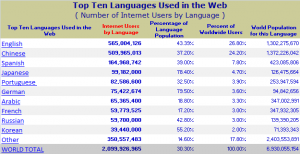If North American-based businesses are to reach the rapidly expanding, increasingly sophisticated international Internet audience, they must get smarter about international search engine optimization.
Just like domestic SEO, the international version boosts the likelihood that a particular website will rise to the top of search results, thereby enabling increased conversion rates.
The challenge internationally is to select the right SEO strategies for an enormous number of locales, cultural norms and languages. For those creating and implementing an international SEO program, it’s helpful to adhere to five key principles.
1. Plan international SEO needs before launching websites abroad
International SEO is instrumental in helping businesses get found online and ensuring visitors stick around once they land on your site. Don’t make your international SEO strategy an afterthought. It should be part of your planning process from the moment you decide to expand internationally.
That planning process begins with keyword research. Determine what keywords your target customers are likely to use. Will they search for your products using the exact translation, or are there local slang terms you need to know?
This information is essential to developing an international website that is optimized for the key factors evaluated by search engine algorithms: meaningful, fresh content that is keyword-specific; descriptive tagging; rich media; social media distribution plans; and internal and external links.
Don’t make global SEO a follow-up item on your globalization to-do list. It should be embedded in every step of the marketing and sales strategy.
2. For authenticity’s sake, avoid completely automated translation
Particularly as you enter a new market or attempt to engage with prospects on social media, an authentic voice is critical. Consumers can easily and widely share any mistakes you make in this area, staining your reputation abroad before you ever gain a foothold in the market.
Multilingual brand messaging can be difficult, and companies should not leave this work to machine translation. Businesses need human experts who can quickly identify faults in automated translations and repair them before damage occurs in important markets.
3. Scrutinize your images as well as your words
The 1,000 words your pictures convey need to be as carefully chosen as the actual text you put on your website. An image can rapidly signal your company’s knowledge or ignorance of a target market.
Localization experts can be helpful here, too, as they are conversant not only in languages, but in cultural norms. For example, a company that fills its pages with images of structures around the world might face unexpected difficulties if one of its photo selections carries a negative connotation locally.
4. Let your prospects make choices regarding language preference
In many countries today, there are enough residents from other regions that it pays to give visitors a choice of language on your website. In Canada, a target might speak English, French, or any number of other languages. In Switzerland, a consumer might prefer to read your content in French, German or English.
Don’t presume to choose the “best” language option for your international websites. Instead, offer a dropdown menu with a wide range of language choices.
5. Monitor and update your content regularly
Just as with English-language search algorithms, pay close attention to content that is changing regularly and to keywords used on the site. If you’re not seeing results, consider updating your keywords and track the impact the changes have on your rankings. Make sure you re-submit your website for indexing every time you make a change to ensure your changes are captured by the relevant search engines.
Why International SEO Matters
A staggering 90-plus percent of today’s Web users live outside the United States, and many of them speak languages other than English.
To break into promising regions in the Americas, the Middle East, Europe and Asia, enterprises are applying the above principles to all of their electronic communication points with customers and therefore maximizing their prospects for success. Earning new business abroad starts with careful translation guided by localization experts and enhanced by smart technology.
In some respects, there has never been an easier time to reach an international customer base. And yet, there are complexities to optimizing international efforts.
A foundation of strategic international SEO removes many of those hurdles by building online outreach on deep awareness of language preferences, cultural norms and search habits of each prospective market.
Opinions expressed in this article are those of the guest author and not necessarily Search Engine Land. Staff authors are listed here.

